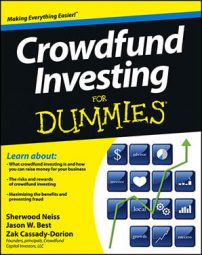The U.S. government has placed limits on the amount that you can put into any crowdfund investments. The U.S. government doesn’t often tell people what they can and cannot spend their money on. However, when it comes to buying stocks in private companies, the government makes an exception. Consider what prompted these investment limits.
Limits on investment in private companies emerged as a direct response to the environment that created the stock market crash of 1929. In the years leading up to the crash, greedy salesmen took advantage of the average Joe, naïve to investing, by selling him shares in invisible or worthless entities.
These smoke-and-mirror tricks created a massive loss of wealth for many people. The government’s subsequent decision to restrict the sale of stock was a decision made with the intent of protecting the masses.
The unintended consequence of the government’s actions was to shut the doors of private company investment even to people who do understand the risks and rewards of investing but aren’t wealthy. Keeping these people out of the markets has slowed down the nation’s innovation and entrepreneurship by making it harder for new and small businesses to access capital.
The JOBS Act signed into law in April 2012 represents a sea change. The federal government understands that investment decisions shouldn’t be based strictly on income or net worth thresholds. After all, consider the case of a finance professor or an accountant — someone who isn’t a millionaire but clearly understands the risks of investing. Shouldn’t that person, and anyone with similar investment knowledge, be able to invest in startups and small businesses?
The challenge is trying to figure out who knows enough to make sound investment decisions and who doesn’t. To coin a new term, who is an educationally accredited investor, and who isn’t? To help make this determination, each online funding portal requires potential investors to take a quiz and demonstrate basic knowledge about the risks involved in these types of investments.
In addition, the online funding portals must (per the JOBS Act) provide investor education materials that all potential investors can access in order to learn more about the risks.
For those who pass muster as educationally accredited investors, the JOBS Act provides an additional layer of protection by capping the amount an individual can invest each year on crowdfund investing campaigns. To be clear, the cap represents the aggregate amount an investor can spend on crowdfund investing each year — not the amount allowable per campaign.
Keep in mind that although the legislation sets the limits on what you can invest, it’s up to you not to exceed those limits. This means that if you make $50,000 and the maximum you can invest in crowdfund opportunities is $2,500, you shouldn’t invest $3,000 in crowdfund opportunities. You should respect the limits for these reasons:
Putting too many of your eggs in the crowdfund investing basket means that you aren’t diversifying your financial portfolio well enough and you’re increasing your risk of loss. Your goal with any investment should be to balance risk and potential reward, and you don’t want to tip yourself too far into the risk territory.
If you go over your limits, you’re essentially proving to the federal government that people are irresponsible and can’t be trusted with their own money. Doing so could encourage people to lobby for truly big government in order to monitor these kinds of individual actions and decisions. Is that what you really want?

